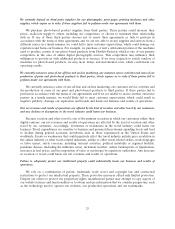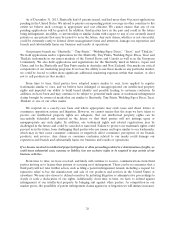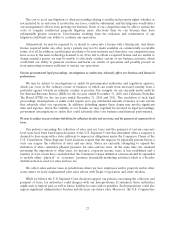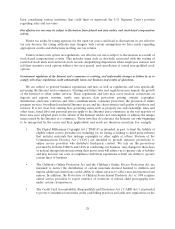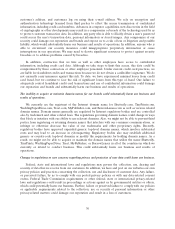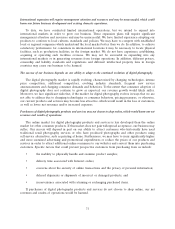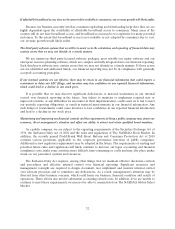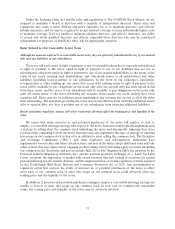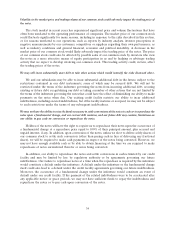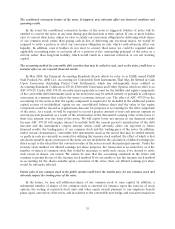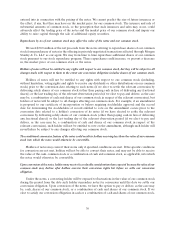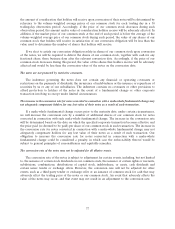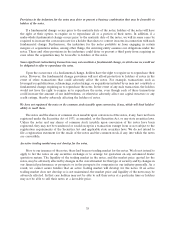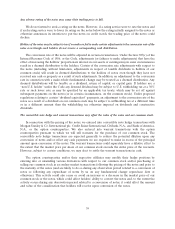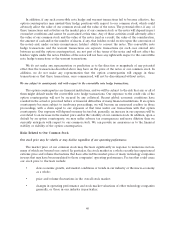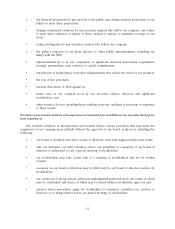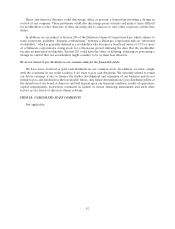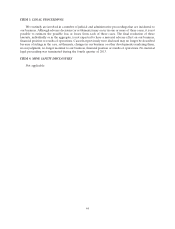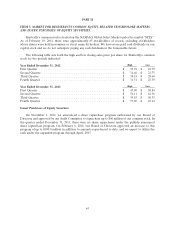Shutterfly 2013 Annual Report Download - page 37
Download and view the complete annual report
Please find page 37 of the 2013 Shutterfly annual report below. You can navigate through the pages in the report by either clicking on the pages listed below, or by using the keyword search tool below to find specific information within the annual report.The conditional conversion feature of the notes, if triggered, may adversely affect our financial condition and
operating results.
In the event the conditional conversion feature of the notes is triggered, holders of notes will be
entitled to convert the notes at any time during specified periods at their option. If one or more holders
elect to convert their notes, unless we elect to satisfy our conversion obligation by delivering solely shares
of our common stock (other than paying cash in lieu of delivering any fractional share), we would be
required to settle a portion or all of our conversion obligation in cash, which could adversely affect our
liquidity. In addition, even if holders do not elect to convert their notes, we could be required under
applicable accounting rules to reclassify all or a portion of the outstanding principal of the notes as a
current rather than long-term liability, which would result in a material reduction of our net working
capital.
The accounting method for convertible debt securities that may be settled in cash, such as the notes, could have a
material effect on our reported financial results.
In May 2008, the Financial Accounting Standards Board, which we refer to as FASB, issued FASB
Staff Position No. APB 14-1, Accounting for Convertible Debt Instruments That May Be Settled in Cash
Upon Conversion (Including Partial Cash Settlement), which has subsequently been codified as
Accounting Standards Codification 470-20, Debt with Conversion and Other Options, which we refer to as
ASC 470-20. Under ASC 470-20, an entity must separately account for the liability and equity components
of the convertible debt instruments (such as the notes) that may be settled entirely or partially in cash upon
conversion in a manner that reflects the issuer’s economic interest cost. The effect of ASC 470-20 on the
accounting for the notes is that the equity component is required to be included in the additional paid-in
capital section of stockholders’ equity on our consolidated balance sheet and the value of the equity
component would be treated as original issue discount for purposes of accounting for the debt component
of the notes. As a result, we will be required to record a greater amount of non-cash interest expense in
current periods presented as a result of the amortization of the discounted carrying value of the notes to
their face amount over the term of the notes. We will report lower net income in our financial results
because ASC 470-20 will require interest to include both the current period’s amortization of the debt
discount and the instrument’s coupon interest, which could adversely affect our reported or future
financial results, the trading price of our common stock and the trading price of the notes. In addition,
under certain circumstances, convertible debt instruments (such as the notes) that may be settled entirely
or partly in cash are currently accounted for utilizing the treasury stock method, the effect of which is that
any shares issuable upon conversion of the notes are not included in the calculation of diluted earnings per
share except to the extent that the conversion value of the notes exceeds their principal amount. Under the
treasury stock method, for diluted earnings per share purposes, the transaction is accounted for as if the
number of shares of common stock that would be necessary to settle such excess, if we elected to settle
such excess in shares, are issued. We cannot be sure that the accounting standards in the future will
continue to permit the use of the treasury stock method. If we are unable to use the treasury stock method
in accounting for the shares issuable upon conversion of the notes, then our diluted earnings per share
would be adversely affected.
Future sales of our common stock in the public market could lower the market price for our common stock and
adversely impact the trading price of the notes.
In the future, we may sell additional shares of our common stock to raise capital. In addition, a
substantial number of shares of our common stock is reserved for issuance upon the exercise of stock
options, the vesting of restricted stock units and other equity awards pursuant to our employee benefit
plans, upon conversion of the notes, and in relation to the convertible note hedge and warrant transactions
35


